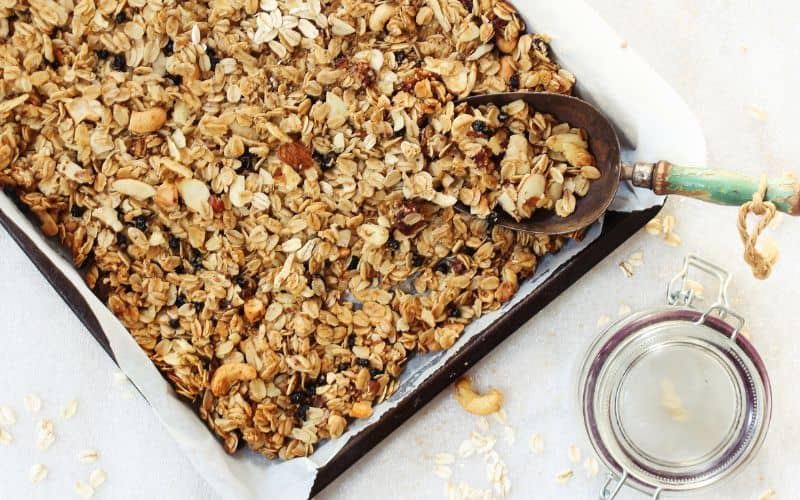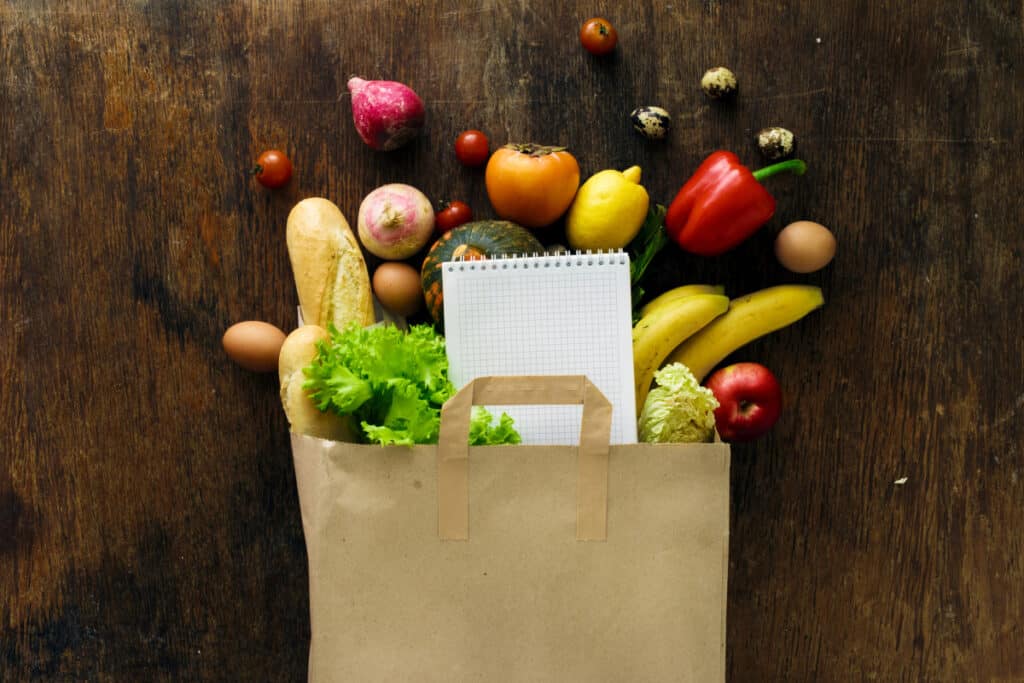When I used to read articles on how to save money on groceries, I would come across mainly two types of advice.
In the first camp: You just need to grow your own fabulous garden, can everything, bake your own bread and become the Queen of Thrift.
The second camp: Simply switch to a smaller sized latte everyday, eat less avocado toast for breakfast and you will SAVE BIG.
See the contrast here?
Both are good thoughts, but may not exactly fit your particular situation.
However, I suspect the gap is closing, regardless of your past spending or lifestyle habits.
Nearly everyone seems to be in the position of having to learn how to save money on groceries in 2023.

Saving Money on Groceries During Inflation
During a time when prices are drastically rising, it’s more important than ever to learn how to shop and spend wisely.
We all still have to eat, and I believe we can eat well and stay within our budgets – with a few changes.
Making extreme commitments to saving money can be necessary at times.
But it can also be overwhelming to try to completely change your spending (and cooking) habits all at once.
Think of all the fad diets that have come and gone:
The same rate of failure applies to budgeting when you “starve” yourself of things you enjoy OR try to change your habits overnight.
And I know for our family of 6, trimming our grocery bill has not been easy. We still have to work very hard to maintain a reasonable balance.
Read Next: Creative Ways to Save More Money when you Have a Big Family
So, I suggest starting small with just a few of these tips this month, and go from there. Small wins can be really motivating!

This post likely contains affiliate links. Please see our disclosure for more info.
Money Saving Tips for Grocery Shopping in 2023
Below are some of my most practical tips and strategies for how to spend less on groceries in 2023 and beyond.
1. Track your food spending for one month FIRST.
This is the classic advice before starting any budget.
But if you’re not already tracking how much you spend on food every month, you have to start here.
Most people have no idea how much is truly flying out the door (or out of their wallet) until they make a realistic food budget.
So here’s what you must do: keep all your grocery and eating out/ fast food receipts for one month, then total them up.
(Yes, it’s painful. But it must be done.)
Then, next month, you can make a list of all your fixed expenses side-by-side your grocery spending —
–and see how much you truly have left over.
From there, you can start making adjustments to how you shop and plan your meals and eating out (or not).
I use the free EveryDollar app to track our entire monthly budget.
I’ve used it for years, actually, and I credit this tool in helping us plan for all our monthly expenses.
2. Make a flexible meal plan and shop once a week (or less)
By flexible, I mean you don’t have to know which meals you’re eating on which nights exactly.
But here’s a secret: planning ahead is the biggest key to saving money on groceries.
So take stock of everything in your pantry, fridge and freezer.
Plan a week of meals around ingredients you already have, first.
Add the missing ingredients to your grocery list.
Keep your list on the fridge or in plain sight where you won’t forget about it.
When you know exactly what you’re going to eat and you have the ingredients on-hand, you won’t be tempted to grab takeout or “run into the store for a few things”.
($75.00 later…)
Every trip to the store adds extra expenses to your overall monthly budget.
A bag of chips here, a new front door mat there…it adds up.
Simply put, the longer between grocery trips, the less money you will spend.
If you’re already doing a weekly meal plan, I suggest trying two weeks or even a month-long meal plan to see how much you save.
When I’m making a long-term meal plan and we run out of snacks or some small ingredient, we try to either:
- Make it from scratch or
- Substitute something else.

More meal planning help here:
•Essentials to stock up in your Freezer and Pantry
3. Learn to cook (everything).
Of course, steps 1 and 2 already assume you cook most meals at home.
But if not, this is the time to learn.
You don’t have to be an amazing cook: you just have to be willing to try.
The more you learn, the more you will save on groceries.
Why?
Because you can start to replace some of those convenience food items with their homemade versions.
Foods like: gravy, taco seasoning, sauces and even bread are not complicated to make once you learn how.

After you review your months’ worth of grocery receipts, you can decide which items are just too costly to buy prepackaged.
Find simple alternatives that you can make at home – one recipe or even one ingredient at a time.
The best news is that homemade will taste better anyhow, and likely be better for you.
4. Shop sale ads and stock up.
Once you’ve tracked your spending for a few months, you should have a better idea of what particular grocery items cost.
Admittedly, grocery store sale circulars used to be a lot more predictable (before 2020).
I knew I could always stock up on things like butter and frozen chicken every X number of weeks, but this is no longer the case.
However, even in 2023 I’ve still been able to find some good deals, and you can, too.
Since I know approximately how low butter will drop, I will only buy it when it’s near that price- and stock up.
My thrifty Grandma always used to say, “When it’s on sale, buy 2”.
Lately, I might buy three or four of one item (as long as there are plenty).
I would suggest considering a stock-up strategy once you see basic staples like canned goods, pasta; and butter and cheese, which are easy to freeze.
Having a good supply of these sale items is one of the best ways to save money on food, over time.

5. Don’t overlook discount grocers and Dollar stores.
We have a few local discount grocery stores that offer steep discounts on overstock and out-of-date products.
I usually steer clear of the dairy and freezer coolers there.
But, for instance, I can find great deals there on fresh produce.
I also look for canned food that is just past the “best buy” date and coffee.
Read here to understand what best by, sell by and expiration dates actually mean. (You might be surprised.)
At our Dollar Tree, I am really selective as well. But if you shop smart, you can find some deals.
You just have to pay attention to the quantities (or price per ounce) in order to accurately compare to the grocery store.
A few things I frequently buy at Dollar Tree:
- Tortillas
- Pink salt
- Shelf-stable whole milk — great for baking and cooking
- Gallons of drinking water (it’s now the best price in my area).
Be sure to look for clearance carts near the checkout, where grocery items will sometimes be marked down half-price.
6. Consider food co-ops, bartering and local offerings.
Azure Standard is one of the few food co-ops that has a drop once a month in our area.
Some of their bulk items I’ve found to be decently-priced, and the quality is good.
It really depends on what type of grocery items you typically buy as to what type of deals you might find.
If you grow a garden or have fruit trees, think of friends you could swap produce with.
My friends and I do this often and it gives me a variety of vegetables to plan more meals or even freeze for later.
For meat, see if a local farmer (or a friend with a few beef cattle) is offering a good price on a ½ or even ¼ of a beef or hog.
You will always beat the grocery store prices by buying meat this way.
Of course- you’re also getting better quality meat and supporting your local farmers and friends.
Even better!
Farmers markets and orchards also have some great deals, especially towards the end of the season.
I can buy bulk apples at the end of the fall at a steep discount. They can be sliced and frozen for pies and jellies all winter.

7. Use Curbside Pickup or order pantry staples online.
I don’t know about you, but walking into the grocery store with my 4 kids and coming out with everything on my list while staying anywhere near what I budgeted?
It’s basically a Christmas miracle I haven’t witnessed yet.
I used to wonder, though – can you REALLY save money by grocery shopping online?
When I started ordering a few grocery items here and there online, I didn’t realize that it could actually save me money AND be a huge time-saver.
More perks of online grocery shopping:
- I can browse grocery items that aren’t available at my local store
- I can take a few days to ponder what I really need versus want, and
- I can adjust my shopping cart to make sure I don’t overspend.
Where I like to shop online:
1| Sam’s Club
I’ve compared prices with other big-box stores near us and for the items we buy regularly, and Sam’s has the best prices in our area.
We also get cashback rewards that we can apply to our grocery order a few times a year. (We have the Plus membership.)
This is one store that I nearly always choose to order online from, or order pickup. There are simply too many tempting things around every corner!
We limit our in-store purchases to just a few times a year for this reason.
However, with free shipping on most items, it’s a no-brainer for busy parents.
TIP: If you don’t have a lot of space for buying bulk items, consider going in with a friend or family member on your purchases and splitting them up.
2| Target (for Pantry Essentials)
First of all, if you don’t have a Target Red Card, you should really consider it for grocery savings alone.
I have the Target debit card option which is linked to my checking account so that I’m not tempted to overspend.
(Well, tempted, yes. But so much easier to do when it’s NOT a credit card, which I don’t recommend.)
Target gives you 5% off plus free shipping (min. $35) on almost everything on their site when you use the Red Card, so that’s a nice incentive —
–especially with the added convenience of shopping online.
While you can’t get everything on your grocery list online, you can get a wide variety of breakfast foods, snack foods, pantry staples and other absolute essentials – like coffee – at decent prices.

3| Vitacost online
If you’re health-conscious, you’ll especially like the variety offered by Vitacost. I recently found some of my favorite health-food items (and more) that I couldn’t find locally.
Surprisingly, the prices were impressive in this economy.
Here are some things I’ve purchased cheaper than anywhere else:
- Bread flour (and other artisan flours for making homemade bread)
- Coconut aminos (a soy sauce alternative)
- No-aluminum baking powder
- Dried beans
- Pasta and spices.
There is usually a decent percentage-off code for new customers, and I frequently get ongoing coupons in my email as well.
Most of the items I’ve purchased were on sale, before adding any coupons.
They run frequent sales on different brands and categories, though.
Also- the shipping is extra speedy with Vitacost! I live in a rural area and received some of my items the very next day.
8. Use half as much meat at dinner time.
Certain types of meat have been hard to find, and what is available is pricey.
Try cutting back on just two meals per week and see if you notice the difference this month.
This works especially well for casseroles or tacos where you can bulk up on other less expensive ingredients.
For example, instead of using one pound of ground beef for your taco meat, brown the meat, and save or freeze 1/2 pound for another meal later on.
Let’s say a pound of ground beef costs $6/pound.
By only using $3 in hamburger and substituting a $0.78 can of black beans, you’re saving $2.22 on just that meal alone.
If you’re making a chicken/brocolli/rice casserole, for instance, add some extra rice and use 1/2 of the chicken the recipe calls for.
(Dice and freeze the other half for later).

9. Label your leftovers
Even in those nice, clear containers, it can be difficult to remember what those leftovers are.
And then they get shoved to the back of the fridge, never to be eaten.
Sadly, nearly 40% of all food in America gets dumped in the trash.
Can you imagine coming home from the grocery store and simply throwing away 40% of everything you bought that day?
Whether in leftovers or neglected produce – that’s a harsh reality to consider.
I was surprised how much better we ate our leftover meals just by labeling them.
(I still use these labels that are easy to remove.)
10. Make freezer meals
If you have a smaller family or simply don’t like eating leftovers, you could throw some freezer meals into the mix.
Simply divide up your meal into two dishes – one in a freezer-safe container to reheat for later.
Some meals are definitely more freezer-friendly than others.
Check out this list of Freezer Meals for some ideas.
Not only does freezing meals cut down on leftovers, it provides a much-welcomed quick meal which is healthier and cheaper than store-bought frozen food.
Having some homemade meals in the freezer also gives you an easy button that helps to avoid stopping for fast food.
11. Learn to love water.
One study showed that the average American drinks about eight 12-oz cans of soda per week.
If you’re “average” in this respect, you could be spending around $40 per month just on soft drinks for you and your spouse in 2022.
And that’s only assuming you’re buying soda at the grocery store.
You can at least triple this number if you’re both stopping for some of those sodas throughout your busy week.
If you buy orange juice, apple juice, or other sweet beverages, let’s estimate two containers of juice per week at $3 each–
–your monthly bill for these non-essential groceries could easily be costing you $64 per month combined.
Side note: A can of Coke has a little over 9 teaspoons of sugar in it!

More reasons to ditch store-bought beverages
I stopped buying juice for my kids long ago – I’m a mean mom – because it’s bad for their teeth and it adds extra sugar to their diet.
Kids will drink more juice than they’ll eat in actual fruit, and they miss out on the fiber by drinking their fruit.
So instead of store-bought drinks, think about how you can love water more:
- Buy a bag of lemons or limes, slice in rounds, then in half. Flash freeze, store in a freezer bag. Pop one into your cup of ice water whenever you want some flavor.
- Look for a fruit infuser water bottle to add other frozen fruit like blueberries or strawberries.
- Add fresh mint (easy to grow in the windowsill!). Can also be frozen in ice cubes.
12. Choose cashback apps carefully
I used to use Ibotta and similar grocery apps, but honestly, I didn’t find them very useful past the first few weeks.
For one, it tempted me to buy name-brand items to get those discounts.
Which, in turn, derailed my thrifty meal plans.
Secondly, it was just one more thing to keep up with.
I found I saved more money by just shopping the store sales and clearance items.
However, you might find different deals in your area and Ibotta might be worthwhile for you.
The one app I still use frequently is BeFrugal.
I try to remember to use this every time I shop for groceries (or anything) online.
Not all retailers participate with BeFrugal, but the ones I frequently shop do, and they offer a small percentage of cashback for purchases.
Keeping my apps simplified helps me to stay focused on my meal plan and not chasing coupons for items I may not need!
Small changes, big savings over time
You can see how small changes can add up big over time.
By going through this list and implementing each of these ideas you could start to see a dramatic savings in your grocery budget.
What other simple and practical ways do you save money on groceries, especially in 2023? Tell us in the comments!
Related Products:
You Might Also Like:
The best frugal living tips for families
The essential food items you should always have stocked
Creative money-saving ideas for families
5 ways to impact your family’s finances for the better this year
Originally published 12/26/18; updated 7/12/23.
This is an excellent post! I am always looking for ways to save on groceries, and it is an almost impossible task!
Groceries are the area in my budget that seems the most logical to cut when trying to save money, since it isn’t a “fixed” expense, but it is a chore to figure out how to do it isn’t it? Some months we do better than others. Thanks for the feedback Kristin!
Thanks again.